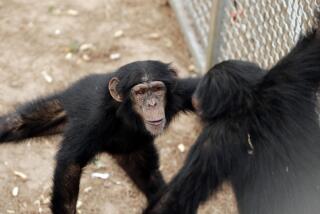Book Review : Is There a Baboon Inside Each of Us?
- Share via
Almost Human: A Journey Into the World of Baboons by Shirley C. Strum (Random House: $22.50; 278 pages)
The textbook description of the scientific method says that better theories replace weaker theories in the dispassionate search for truth.
A “better theory” is one that explains more data or that links up with other theories, and the textbooks would have you believe that when one of them comes along, scientists rush pell-mell to embrace it.
In reality, they do nothing of the sort. Like everyone else, scientists have a vested interest in the status quo. Many of them have made their reputations and based their careers on existing theories, and they are not eager to admit that they were wrong.
Shirley C. Strum, an anthropologist at UC San Diego, discovered this fact of scientific life soon after she began a remarkable study of baboons in Kenya 15 years ago. Her observations of the social structure of these intelligent monkeys conflicted sharply with the conventional scholarly view of them.
At first she distrusted her observations. But then, as she gathered more data, she became convinced that the view that baboon society was based on male aggression was wrong. In fact, she found, male aggression was rare, and females controlled the group. What’s more, intelligence and cooperation were the key factors in explaining how these animals behaved.
More Than Academic Interest
These findings have more than academic interest, as the title of Strum’s book, “Almost Human,” implies. Because baboons are almost human, the conclusion that they are inherently aggressive and that their society is based on power has been used to argue that the same factors control human society as well. After all, it is said, aggression is in our genes. Different conclusions about baboons would imply different conclusions about humans.
“What if inside us humans lurked the legacy not of a killer ape, but of a polite and sophisticated baboon?” she asks.
At the start of her research, Strum laid out her goals: “What are baboons really like?” she wondered. “How useful are they in our quest to understand ourselves? This was what I hoped to discover.”
She spent several years in Kenya closely observing several troops of baboons and meticulously gathering information about them before she began to report her findings. Her descriptions of conducting such field work and of the personal hardships involved in it are very interesting and instructive.
‘Socially Smart’
Straightaway she found that her field observations conflicted with conventional wisdom. “I was seeing things I was not supposed to be seeing, finding patterns that were not supposed to exist. Worse still, I was not finding patterns that everyone else said did exist. . . .
“Everywhere I looked I found socially smart animals. As social diplomats, they employed finesse--social strategies, sophisticated maneuvers and reciprocity--for their very survival. I had discovered extraordinary intelligence, planning and insight in their interactions with one another, both as individuals and as members of real or constructed families. . . . Real power resided with those who were ‘wise’ rather than those who were ‘strong,’ those who could mobilize allies rather than those who try to push through with brute force.”
Strum gives many detailed examples to support these conclusions, and she writes of the baboons she studied with an appealing warmth and affection. She also wondered whether she was projecting human values onto monkeys.
Made Decisions
“Was it anthropomorphic to believe that baboons were intelligent manipulators of their social world; to think that they weighed alternatives and made decisions; to think that even without language they had mental symbols that allowed them to think first and act later, that allowed them to create remarkable unwritten contracts of social reciprocity?” she asks. “Upon reflection, it seemed particularly human, particularly anthropocentric to deny them these abilities.”
But even more eye-opening is the reception she got when she began reporting her results at anthropology meetings in the United States. Despite years of observations, voluminous data and a theory that explained it, she was ignored or dismissed.
When she presented her papers, other anthropologists coughed politely and moved on. Or they attacked her, sometimes arguing that she had invented her data or misinterpreted it or that she had simply missed what was really happening with the baboons.
“I was naive,” Strum writes. “I had imagined that one did research, gathered the information, analyzed, interpreted and presented it to the scientific world. Then the work would be evaluated and incorporated, if accepted, into the basic knowledge of the field. But there are cliques in science as in any other facet of human endeavor. If you are part of the ‘in’ group, even minor findings are discussed and integrated, eventually becoming part of the working knowledge in the field. If you are not part of the clique, you stand a good chance of being ignored.”






